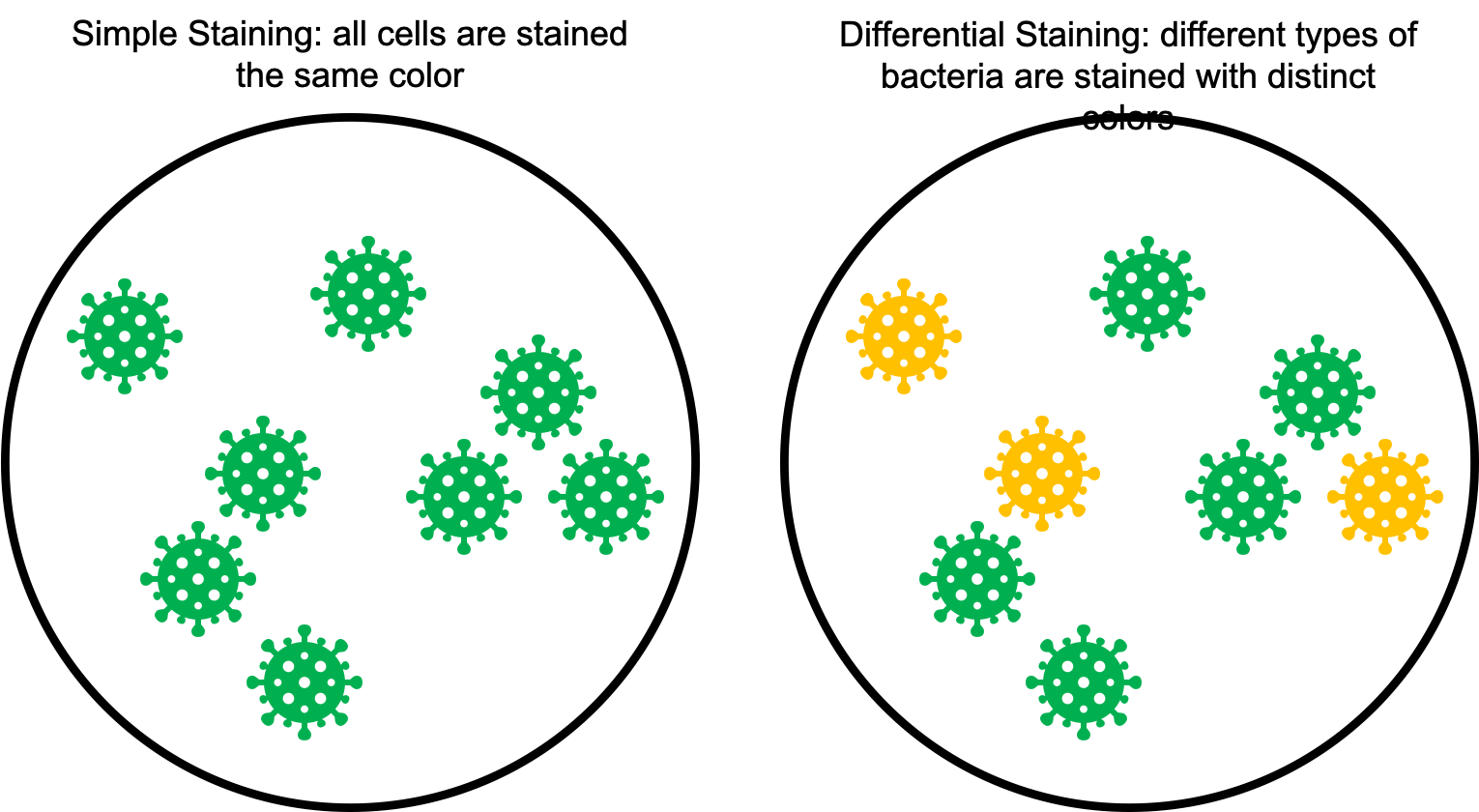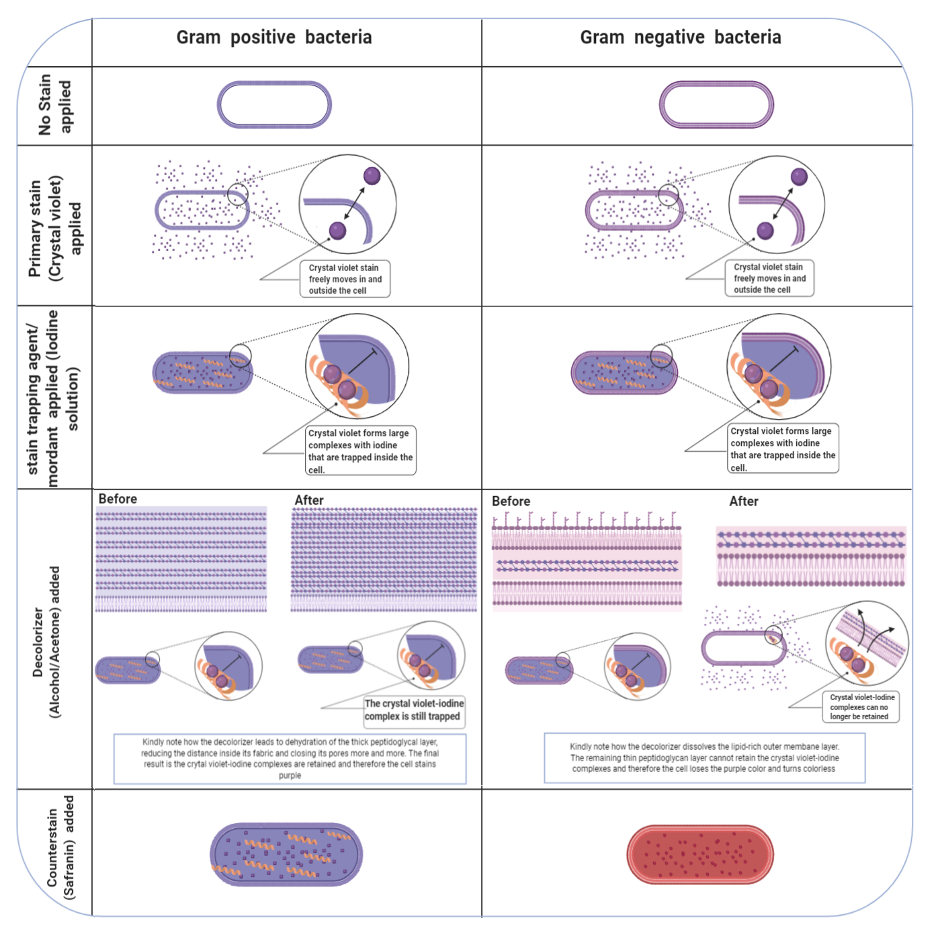By Mohamed Nasr
Fun rating: 5/5

Difficulty rating: 1/5

What is the general purpose?
Gram staining is used to differentiate between two large groups of bacteria according to their cell wall structure differences (Figure 1).
Why do we use it?
Gram staining is an essential technique in the field of microbiology. It is used in a wide variety of applications, such as scientific research and medical diagnostics.
For example, patients with bacterial infections might need quick treatment to prevent the infection from spreading. Gram staining gives rapid results that can provide doctors with information about what category the infection-causing bacteria belongs to. Once the doctor knows what type of bacteria is causing the infection, they can prescribe the right kind of antibiotic to prevent further spread while they wait on results from other more specific tests.
How does it work?
Intro and History

In microbiology, staining techniques can be divided into one of two types: simple and differential. In simple staining, all cells are given the same color and therefore you cannot differentiate between different types of bacteria based on their color. On the other hand, differential staining stains different types of bacteria with distinct colors which enables us to visualize different kinds of bacteria under a microscope.
Gram staining is a type of differential staining. Gram staining was introduced by Danish scientist Hans Christian Gram in 1884 when he noticed that some types of bacteria could retain crystal violet staining, while others couldn’t. He called the bacteria that could retain the stain “Gram positive”, and called the bacteria that couldn’t “Gram negative”. Gram staining is based on the fact that bacteria have structural differences in their cell walls. Some bacterial cell walls have a thick peptidoglycan layer, which is a layer of protein-sugar complexes, and others have a thin peptidoglycan layer and an outer lipid-rich membrane (Figure 2). In the experiments Hans Gram has performed, the Gram positive bacteria were the bacteria with thick peptidoglycan layers; and the Gram negative bacteria were the bacteria with thin peptidoglycan layers and lipid-rich outer membranes.

Idea and procedures layout
Gram staining involves the use of a reagent, called a decolorizer, that has different effects when applied to the cell walls of Gram positive and negative bacteria (see Fig 3). The general procedure involves __ major steps:
- The bacteria are first stained with a the primary stain, crystal violet. This stain colors all the cells purple and can freely enter and exit both types of bacteria.
- An iodine solution (also known as mordant) is then added to the bacteria, which traps the crystal violet stain inside the cell, by forming large complexes with the crystal violet stain. In Gram negative bacteria, the lipid-rich outer membrane further aids in the trapping of the crystal violet-Iodine complexes. At this stage, both types of cells are stained purple.
- The decolorizer, normally alcohol or acetone, is then added. The decolorizer acts differently on the cell walls of Gram negative and positive bacteria. In Gram negative bacteria, the decolorizer dissolves the lipid-rich outer membrane layer and since this layer is very thin, it cannot retain the the crystal violet-Iodine complexes. In Gram positive bacteria, the decolorizer dehydrates the thick peptidoglycan layer, which then tightens and closes. Thus, the Gram positive bacteria is able to retain the crystal violet-Iodine complexes. At this stage of the experiment, you can only visualize Gram positive bacteria in purple while Gram negative bacteria are colorless due to the stain leakage after applying the decolorizer. It’s crucial to keep an eye on the clock while performing this procedure, since applying the decolorizer for more than 15 seconds will end up decolorizing both Gram positive bacteria and Gram negative bacteria.
- Finally, a counterstain is applied to visualize the Gram negative bacteria. The most commonly used counterstains are safranin and carbol fuchsin, which stain Gram negative bacteria pink. So by the end of the experiment, Gram positive bacteria stains purple while Gram negative bacteria stains pink.

Edited by Alan Curtis and Rachel Battaglia
Rating illustrations by Brooke Felsheim
Editor’s Note: Below see a picture taken with a light microscope showing a successful Gram stain. The purple cells are Staphylococcus epidermidis (a bacterial organism commonly found on skin) and the pink cells are Escherichia coli.

